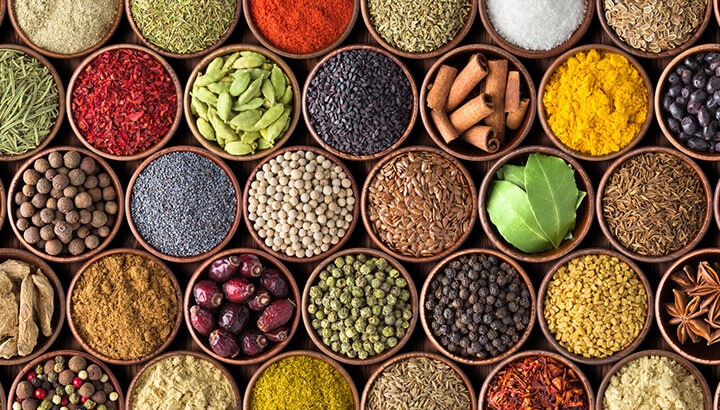We associate the word “spice” with flavor, stimulation, and a zest for living. People talk about spicing up their relationships, their writing, and of course, their meals. It is natural to think of spices as enhancements that enrich our lives.
Spices Through Human History
Why has the word “spice” acquired such a positive connotation? It probably has a lot to do with the fact that the seasonings people have been using for thousands of years to preserve food, enhance meals, and as herbal remedies which tickle the taste buds and promote health in remarkable ways. Here are just a few of the ways common spices have been used over the centuries:
- The ancient Egyptians recognized that herbs and spices could help preserve foods and bolster health.
- Chinese seafaring merchants, dating back to at least the 5th century BC, grew spice plants on their ships to help protect sailors from scurvy.
- Spices were extensively cataloged in Indian Ayurvedic medicine for their medicinal properties. As early as the 1st century BC, compounds from sesame seeds were utilized as an antiseptic, cloves and cardamom were used to improve digestion, and turmeric was prescribed to treat rheumatism.
- During the Middle Ages, peppercorns and other spices were often used as a form of currency.
- Explorers like Marco Polo and Christopher Columbus were motivated to find new trade routes by the prospects of discovering valuable spices.
- From the 16th through the 18th century, the fate of countries and empires often rested on the spice trade. There’s even a legend that pepper pot soup (which was consumed by General George Washington’s soldiers at Valley Forge) helped fortify U.S troops in their campaign against the British. Did spiced soup play a pivotal role in the Revolutionary War? There are some reasons to believe the story is apocryphal, but the myth highlights how important spices were in colonial times.
Spices Are Packed With Health Benefits
In the past, spices were often considered the foundation of medicine and a cornerstone of commerce. Today, they are often just another bottle collecting dust in our kitchen pantries.
But I want to encourage you to take more time to consider both the health and culinary benefits of spices. The flavor-enhancing qualities of these plant-derived seasonings are undeniable. Spices have been an integral part of Mediterranean, Asian, and Indian cuisine for thousands of years because they are a great way of adding zest to meals. The healing properties of spices have also long been recognized in these cultures as evidenced by their prominent place in Chinese and Ayurvedic medicine.
But the role spices can play in promoting health is comparatively (perhaps completely) overlooked in Western medicine. Conventional medicine spends inordinate resources cataloging diseases and conditions. Similarly, lots of time and effort is spent identifying foods that promote (or undermine) health. But apart from studies being done in Asia and India, there is comparatively little research on how herbs and spices impact health.
The Standard American Diet (SAD) is extremely bland…largely because it contains very low levels of herbs and spices. And the people who eat the SAD have extremely poor health. This correlation has always made me wonder, could the deficiency of herbs and spices in the American diet be a part of the puzzle when it comes to the epidemic of chronic disease so many people are suffering from?
One recent study, published in the journal BMJ, suggests that I might be onto something. It found that increased consumption of spicy foods was correlated with a substantial (14 percent) reduction in overall mortality.
Here are a few important things we are learning about some very popular spices and how they can bolster your health:
- Cinnamon. The evidence continues to mount that Ceylon cinnamon (also called “true” Cinnamon) is an antioxidant powerhouse that can help regulate blood glucose and lower cholesterol. Not all cinnamon is created equal, so be sure to choose Ceylon cinnamon over the Cassia variety. The latter is lower cost but also lower quality.
- Ginger is loaded with a bioactive compound called gingerol, which is a natural oil with powerful antioxidant and anti-inflammatory properties. It is widely known for its anti-nausea effects, but is also has antimicrobial, muscle relaxation, and positive digestive effects.
- Garlic is one of the most versatile herbs on the planet. It is rich in allicin, which helps lower cholesterol and blood pressure. Garlic is also a broad-spectrum antimicrobial agent.
- Saffron is widely used in Mediterranean countries (particularly Spain) where it is used to add flavor to dishes like paella. Animal studies show it is rich in a compound called crocetin, which is heart healthy and has been shown to work like an antidepressant to improve mood and energy.
- Turmeric has been used in India for thousands of years to flavor cuisine, to dye textiles, and as an Ayurvedic medicinal remedy. It is loaded with bioactive compounds (especially curcumin) that counteract inflammation, improve circulation, and boost neurotrophic factors that promote cognitive health.
- Cumin is the second most popular spice worldwide (right after black pepper). It been used for thousands of years as a digestive aid, to fight infections, and reduce coughs and respiratory problems.
- Paprika. According to a 2016 Plant Foods for Human Nutrition report, just one serving of paprika delivers one of the most potent doses of antioxidants you can get anywhere.
- Oregano has been used to add flavor to meals for thousands of years, but this Mediterranean herb is chock full of phytonutrients, natural antiseptic agents, and antioxidants. The antibacterial properties of oregano are so powerful that researchers in the UK concluded that, “…the essential oil from the oregano kills MRSA at a dilution 1:1,000.”
- Rosemary is Mediterranean herb from the mint family. Studies suggest it can improve memory, boost immune function, and help improve the hepatic detoxification system.
- Cardamom. A 2013 study published in the Asian Pacific Journal of Cancer Prevention found that cardamom was rich in anti-cancer compounds.
- Cayenne pepper. Derived from red peppers, this spice is used to spice up recipes across the globe. It’s loaded with phytonutrients (including astaxanthin) which have anti-inflammatory, pain relieving, and metabolism boosting effects.
I hope that convinces you to dust off those little bottles in your spice rack and get cooking!
For the best and healthiest source of turmeric, we recommend Golden Revive+. This turmeric is combined with 5 other amazing ingredients including Boswelia, Bromelain, Magnesium, Quercetin and Black Pepper, creating an inflammation-fighting cocktail! It is 200X more effective than any other turmeric on the market. And for a limited time, You can get a FREE bottle by clicking here =>
Take good care,
Dr. Josh









